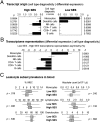Social stress up-regulates inflammatory gene expression in the leukocyte transcriptome via β-adrenergic induction of myelopoiesis
- PMID: 24062448
- PMCID: PMC3799381
- DOI: 10.1073/pnas.1310655110
Social stress up-regulates inflammatory gene expression in the leukocyte transcriptome via β-adrenergic induction of myelopoiesis
Abstract
Across a variety of adverse life circumstances, such as social isolation and low socioeconomic status, mammalian immune cells have been found to show a conserved transcriptional response to adversity (CTRA) involving increased expression of proinflammatory genes. The present study examines whether such effects might stem in part from the selective up-regulation of a subpopulation of immature proinflammatory monocytes (Ly-6c(high) in mice, CD16(-) in humans) within the circulating leukocyte pool. Transcriptome representation analyses showed relative expansion of the immature proinflammatory monocyte transcriptome in peripheral blood mononuclear cells from people subject to chronic social stress (low socioeconomic status) and mice subject to repeated social defeat. Cellular dissection of the mouse peripheral blood mononuclear cell transcriptome confirmed these results, and promoter-based bioinformatic analyses indicated increased activity of transcription factors involved in early myeloid lineage differentiation and proinflammatory effector function (PU.1, NF-κB, EGR1, MZF1, NRF2). Analysis of bone marrow hematopoiesis confirmed increased myelopoietic output of Ly-6c(high) monocytes and Ly-6c(intermediate) granulocytes in mice subject to repeated social defeat, and these effects were blocked by pharmacologic antagonists of β-adrenoreceptors and the myelopoietic growth factor GM-CSF. These results suggest that sympathetic nervous system-induced up-regulation of myelopoiesis mediates the proinflammatory component of the leukocyte CTRA dynamic and may contribute to the increased risk of inflammation-related disease associated with adverse social conditions.
Keywords: immunology; social genomics.
Conflict of interest statement
The authors declare no conflict of interest.
Figures




Similar articles
-
Regulation of systemic and local myeloid cell subpopulations by bone marrow cell-derived granulocyte-macrophage colony-stimulating factor in experimental inflammatory arthritis.Arthritis Rheum. 2011 Aug;63(8):2340-51. doi: 10.1002/art.30354. Arthritis Rheum. 2011. PMID: 21809323
-
Social regulation of the lymph node transcriptome in rhesus macaques (Macaca mulatta).Psychoneuroendocrinology. 2017 Feb;76:107-113. doi: 10.1016/j.psyneuen.2016.10.029. Epub 2016 Nov 14. Psychoneuroendocrinology. 2017. PMID: 27902946 Free PMC article.
-
β-Adrenergic receptor antagonism prevents anxiety-like behavior and microglial reactivity induced by repeated social defeat.J Neurosci. 2011 Apr 27;31(17):6277-88. doi: 10.1523/JNEUROSCI.0450-11.2011. J Neurosci. 2011. PMID: 21525267 Free PMC article.
-
Regulation of myeloid development and function by colony stimulating factors.Dev Comp Immunol. 2004 May 3;28(5):509-54. doi: 10.1016/j.dci.2003.09.010. Dev Comp Immunol. 2004. PMID: 15062647 Review.
-
Monocytes and dendritic cells in a hypoxic environment: Spotlights on chemotaxis and migration.Immunobiology. 2008;213(9-10):733-49. doi: 10.1016/j.imbio.2008.07.031. Epub 2008 Sep 21. Immunobiology. 2008. PMID: 18926289 Review.
Cited by
-
The brain-body energy conservation model of aging.Nat Aging. 2024 Oct;4(10):1354-1371. doi: 10.1038/s43587-024-00716-x. Epub 2024 Oct 8. Nat Aging. 2024. PMID: 39379694 Review.
-
Association Between Social Isolation With Age-Gap Determined by Artificial Intelligence-Enabled Electrocardiography.JACC Adv. 2024 Mar 20;3(9):100890. doi: 10.1016/j.jacadv.2024.100890. eCollection 2024 Sep. JACC Adv. 2024. PMID: 39372468 Free PMC article.
-
The impact of social relationships on the risk of stroke and post-stroke mortality: a systematic review and meta-analysis.BMC Public Health. 2024 Sep 4;24(1):2403. doi: 10.1186/s12889-024-19835-6. BMC Public Health. 2024. PMID: 39232685 Free PMC article.
-
Social defeat stress impairs systemic iron metabolism by activating the hepcidin-ferroportin axis.FASEB Bioadv. 2024 Jul 2;6(8):263-275. doi: 10.1096/fba.2024-00071. eCollection 2024 Aug. FASEB Bioadv. 2024. PMID: 39114446 Free PMC article.
-
Beta2 adrenergic receptor-mediated abnormal myelopoiesis drives neuroinflammation in aged patients with traumatic brain injury.Sci Adv. 2024 Jul 19;10(29):eadp5239. doi: 10.1126/sciadv.adp5239. Epub 2024 Jul 19. Sci Adv. 2024. PMID: 39028822 Free PMC article.
References
Publication types
MeSH terms
Substances
Associated data
- Actions
- Actions
- Actions
Grants and funding
- DE014320/DE/NIDCR NIH HHS/United States
- AG033590/AG/NIA NIH HHS/United States
- AG107265/AG/NIA NIH HHS/United States
- R01 MH097243/MH/NIMH NIH HHS/United States
- R01 AG034052/AG/NIA NIH HHS/United States
- R01 MH093473/MH/NIMH NIH HHS/United States
- CA116778/CA/NCI NIH HHS/United States
- R01 CA116778/CA/NCI NIH HHS/United States
- MH093473/MH/NIMH NIH HHS/United States
- R01 MH046801/MH/NIMH NIH HHS/United States
- R37 AG033590/AG/NIA NIH HHS/United States
- P30 AG017265/AG/NIA NIH HHS/United States
- P01 AG018911/AG/NIA NIH HHS/United States
- MH46801/MH/NIMH NIH HHS/United States
- R01 HD058502/HD/NICHD NIH HHS/United States
- HD058502/HD/NICHD NIH HHS/United States
- T32 DE014320/DE/NIDCR NIH HHS/United States
LinkOut - more resources
Full Text Sources
Other Literature Sources
Medical
Molecular Biology Databases

